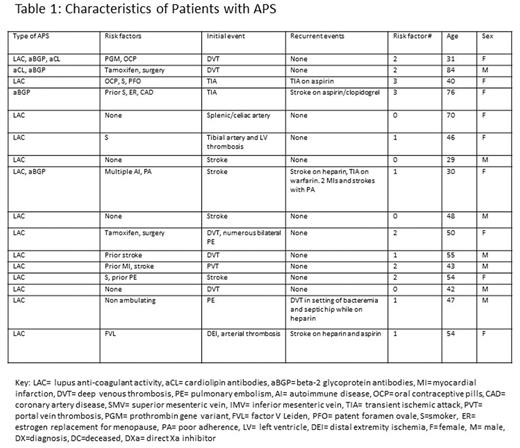Abstract
Introduction: Antiphospholipid syndrome (APS) is a pro-thrombotic, autoimmune mediated clinical syndrome associated with increased propensity for venous and arterial thrombosis and recurrent fetal loss. A significant clinical heterogeneity exists in the condition ranging from minor easily managed venous thromboses and TIAs to unusual, catastrophic, or refractory thromboses. It is generally unknown what factors are useful in predicting the clinical course. Our goal was to characterize our cohort and to look for any other factors that may be associated with thrombosis.
Methods: We analyzed the records of 979 patients seen in a single physician cohort over a 4-year period at an academic institution. 81 had some mention of APS. Out of 81 patients, 23 patients were included. Seven of these patients did not meet our criteria precisely, but were considered as having APS due to high clinical suspicion by the treating physician. We defined APS by the presence of a thrombotic event or recurrent fetal loss in association with one of the following laboratory criteria repeatedly positive at least 12 weeks apart: Lupus anticoagulant (LAC), Beta-2 Glycoprotein antibodies (aB2GP), Cardiolipin antibodies (aCL). Cardiolipin and Beta-2-Glycoprotein antibodies were defined as abnormal if levels were above 40 mpl/gpl; IgA antibodies for Beta-2-Glycoprotein were also allowed. The tests for LAC were as follows: dilute Russell Viper Venom time (dRVVT), hexagonal lipid neutralization, partial thromboplastin time (PTT) mixing study, and tissue thromboplastin inhibition (TTI) 1:50/1:500. The TTI could not be the only abnormal test and TTIs were excluded if the Prothrombin time (PT) was prolonged for any reason. LAC tests done with patients on dabigatran, apixiban, or rivaroxaban were considered uninterruptable.
Results: Table 1 and Table 2 outline our findings. As we had so few double or triple positive patients we were unable to detect a difference in clinical severity related to the number of laboratory criteria met. 6/14 women were on hormonal therapy at time of diagnosis. 5/18 patients who were tested for thrombophilias were found to have one; three with prothrombin gene variant (PGM) and two with factor V Leiden (FVL). In carefully assessing for concurrent risk factors, 18/23 (78%) of our patients had at least one risk factor for thrombosis, 9 (39%) had at least two risk factors, and four (17%) had at least three risk factors. Notably all five (22%) of the patients with no preexisting risk factors had no recurrence of thrombosis. We also found that two (9%) of our patients normalized the APS laboratory abnormalities over time.
Discussion: Thrombophilia testing in patients with thromboses has grown dramatically over the last several decades and there are questions as to the utility in managing patients. The presence of antiphospholipid antibodies that are associated with APS, can be seen in asymptomatic patients, but are also seen in patients with catastrophic thromboses, thromboses refractory to anticoagulation, and in thromboses in unusual locations. In our case series, most patients were single positive and most had concurrent risk factors for thrombosis. We did not see evidence that double or triple positive APS patients had a more severe clinical course as compared to single positive patients, but we had so few multiple positive APS patients to allow us to conclude this with any certainty. An interesting observation was how many of the patients in our cohort had other known risk factors for thromboses specifically FVL, PGM, and hormonal therapy. We noted that patients with no other known risk factor other than APS seemed to have a better clinical course, while those with multiple risk factors had a more severe clinical course. Lastly, we noted some patients, who had met the diagnostic criteria for LAC, had their laboratory testing normalize over time. We plan to extend this case series in a larger patient cohort at our institution.
No relevant conflicts of interest to declare.
Author notes
Asterisk with author names denotes non-ASH members.



This feature is available to Subscribers Only
Sign In or Create an Account Close Modal